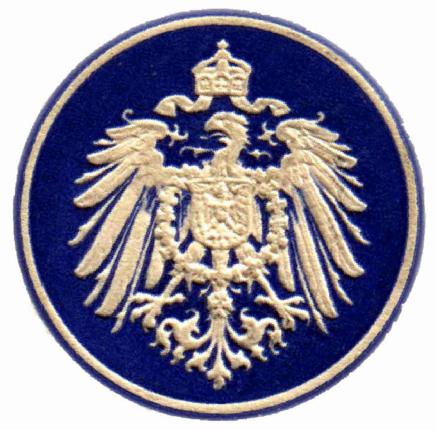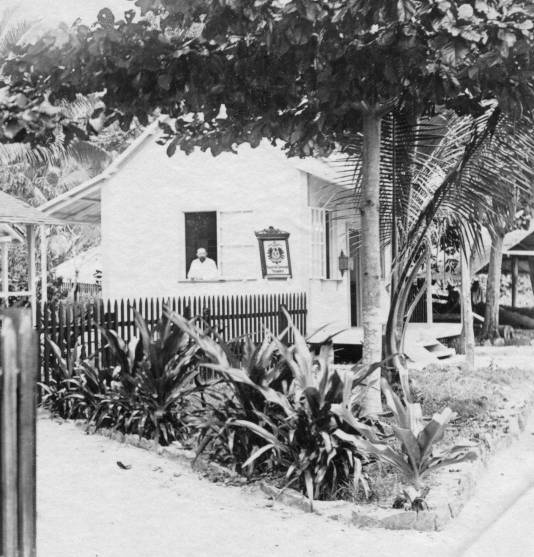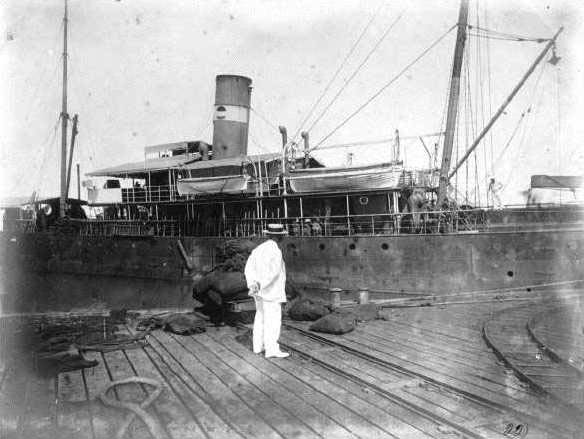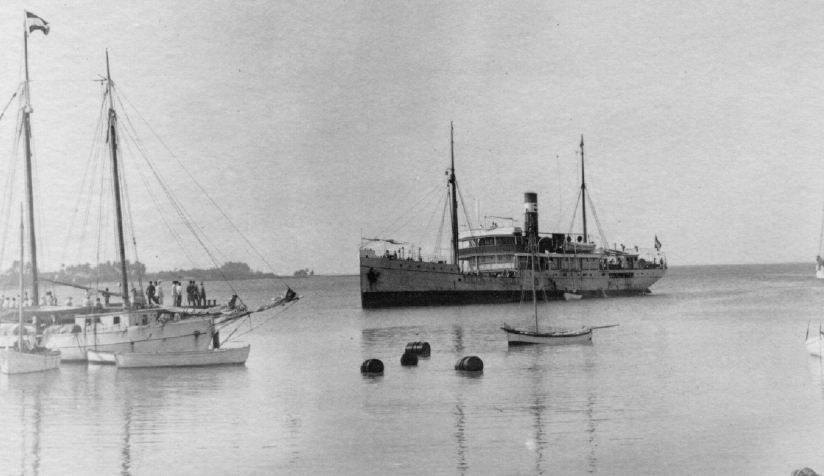

|

|
Stamps and Postal History of the German Marshall Islands 2 – German Postal Services on Jaluit by Dirk H.R. Spennemann |
|
After the annexation of the Marshall Islands in 1885 the German administration moved to regulate and stimulate the economic activity in the islands. This entailed the establishment of reliable shipping connections and the establishment of a reliable communications systems. A functioning postal service was an essential ingredient of this strategy. [1] |
|
The Commencement of Postal Services
|
|
The standard mail services to and from the Marshall went through Jaluit, which had been declared sole port of entry on 28 June 1888.[3] A month earlier, on 27 April 1888, the German Imperial Ost Office has decreed that a postal agency be established in Jaluit, and had directed the postal directorate (Oberpostdirektion) Hamburg to arrange for the transmission of the necessary stamp stock and paraphernalia, particularly the official seal, a cancellers and other items. The Imperial Post Office did not allow much time for this to occur, as the equipment was to be sent on the Norddeutscher Lloyd steamer departing Brindisi on 4 May, which necessitated sending from Hamburg by Express mail no later than 1 May.[4] The postal directorate was further directed to make a small amount of material available and send it by mail via the NDL steamer to Sydney, and from there by private vessel to Jaluit. The bulk of the initial establishment was to be sent driectly from Hamburg in June or July, using a Jaluit Gesellschaft sailing vessel scheduled to depart about that time for the Marshalls. On 30 April 1888 the postal directorate Hamburg sent the following stamps and postcards to Jaluit. |
| Initial establishment of the Jaluit Post Office [6] | ||
|---|---|---|
| Value | Quantity | |
| 5 Pf Stamps | 2,000 | |
| 10 Pf Stamps | 2,000 | |
| 20 Pf Stamps | 4,000 | |
| 50 Pf Stamps | 500 | |
| 2 Mark Stamps | 200 | |
| 10Pf post cards | 500 | |
| 10+10Pf reply post cards | 100 | |
| Of these sent by mail on 1 May 1888: | ||
| 5 Pf Stamps | 100 | |
| 10 Pf Stamps | 300 | |
| 20 Pf Stamps | 500 | |
| 50 Pf Stamps | 200 | |
| 10Pf post cards | 100 | |
|
The express mail letter, which was routed via Sydney and Samoa was misdirected in Samoa and did not arrive in time for the projected opening of the post office on 1 October 1888. from that day onwards, the Jaluit Post Office, even though not yet opened, formed part of the World Postal Union. [7] The main crate with the post office supplies, shipped from Hamburg on 14 August 1888, arrived in Jaluit on 16 March 1888. The Post Office on Jaluit was opened on 29 March 1889.[8] The stamps used were standard issue German Empire stamps (see Vorläufer). At first the post office was a section of the administrator's office. Later, a small dedicated post office building was erected right next to the Imperial Administrator's building ('Landeshauptmannschaft'). That post office had a standard issue letterbox and a large post office sign out front. |

The German Post Office on Jaluit before the typhoon of 30 June 1905.
|
History before the establishment of the Jaluit Linie
Period of uncertain deliveryThe annual reports for the financial year 1891 to 1893 show the nature of the early mail service.[10] In total, mail arrived 16 to 20 in the protectorate, while it left on 16 to 27 occasions. The detailed breakdown shows the range of distinations to which the mail would transported before it could be transshipped to mail steamers with a regular run. The postal connections laregely relied on trading vessels being prepared to take the mails to a normal postal service location, such as Sydney, San Francisco and Manila. The mail to Berlin via San Francisco took on average only 50 days, while mail sent via Sydney could take at least 70 days. When the San Francisco trading firm A. Crawford & Co closed down its Marshall Islands business in 1893, this faster mail service was discontinued.[11] |
| Mail Service to and from Jaluit 1 January 1891 to 31 March 1894 [12] | ||||||
|---|---|---|---|---|---|---|
| 1891 | 1 Jan 1892 - 31 March 1893 | 1 April 1893 to 31 March 1894 | ||||
| Incoming | Outgoing | Incoming | Outgoing | Incoming | Outgoing | |
| Total | 20 | 16 | 17 | 27 | 16 | 18 |
The Pohnpei to Manila RouteThe postal service became much more reliable from autumn 1894 onwards, when a regular bi-monthly sailing vessel service to Pohnpei was established, which connected to the Spanish mail steamer going to Manila, and onwards with another Spanish mail steamer to Singapore. There the service connected with Spanish and French mail steamers going to Europe arriving either at Marseille (France) or Barcelona (Spain) [13].The mail out departed on German or British mail steamers from Brindisi. The mail service to Pohnpei was carried out by the Jaluit Gesellschaft using small schooners. The normal mail carried were letters and newspapers. Some semblance of predictability of mail delivery times occurred with the commencent of FY 1895/96. [14] . Despite this the dates for the departure of mail from Germany to Jaluit, and the arrival of mail from Jaluit in Germany varied widely before scheduled direct mail steamer services could be established. Actual dates could vary even more (see compilation of actual mail times from Jaluit and from Germany). |
Mail via SydneyThe outbreak of the Spanish-American War and the blockade and subsequent capture of Manila by the squadron of Admiral Dewey on 1 May 1898 disrupted this communications link. While the German Navy was authorised to carry mail from the Philippines [16], this was of little use as the connection from Pohnpei to Manila was severed. As an interim measure the outgoing mail from Jaluit was again sent via sailing schooners to Sydney. If and when the opportunity arose, mail was also sent via San Francisco. The mail to Jaluit went on a weekly basis to Sydney and from there at the earliest opportunity to Jaluit.[17]. Because of the mixed conditions of delivery the Reichs-Postamt could not compile accurate statistics for the postal volume for 1898. This type of service service continued until 1900,[18] with attempts to make use of the Cuxhaven--New York--San Francisco mail as well.[19] To remedy the situtaion, and to tie in the newly acquired colonies of the Carolines, Palua and Marianas, the German administration planned to extend an existing Norddeutscher Lloyd service from HongKong to Sydney with additional stop-overs at Saipan and Pohnpei. This entailed a six-weekly service, which also would increase the mail service to German New Guinea. Yap and Jaluit would be relaint on a sailing connection to Pohnpei. At the same time, the Jaluit Gesellschaft proposed to establish a hevily subsidised HongKong-Micronesia-Sydney route is also discussed.[21] |
Until 1 Mai 1899 the Jaluit postoffice was only authorised to use the franking of the world postal union. A postal parcel service was initiated in 1899.[22] Once the new stamps were available, stamp dealers created a substantial demand for franked letters. On 8 August 1899 the philatelic demand for registered letters, driven by the large stamp dealers, was such that the registration labels had been used up. Additional letters had to be registered with the numbers written by hand using red ink.[23] |
However, the service was only short-lived. There was no anchorage off Saipan and the sea was often too rough to effect a secure landing of passenger and mails. Indeed in August 1900 on the second visit of the München, then en route from HongKong to Sydney, the small open boat that had brought the medical aide and post master Woitschek, was smashed against the hull of the steamer in heavy seas, and sank. As landing a ship's boat was out of the question given the weather, Woitschek and his Chamorro boat crew had to be taken to the next port of call, Pohnpei in this case, to be returned on the next trip several weeks later.[26] Not only was the roads off Saipan was too insecure but the business derived from the new route was minimal. The mail contract provided some revenue, but not enough to warrant the stops. By autumn 1900 it was decided to drop both Saipan and Pohnpei from the run, but to include Yap instead. On the maiden voyage of the new run, the München left Sydney on 25 January 1901 but ran aground at Yap on 3 February and had to be written off.[27] |
|
History after the establishment of the Jaluit Linie
The Oceana ServiceTo provide a reliable communication with the German colonies the German government contracted the Jaluit Gesellschaft to provide mail service connecting Sydney, Jaluit and Yap, where the mails could be transshipped to the Norddeutscher Lloyd steamers.[28] This service was upheld by the German Postal steamer Oceana. The initial route ran Sydney – Jaluit – Pohnpei – Yap – Palau – Pohnpei – Jaluit – Sydney. Voyages commenced 1 January 1901. When the Norddeutscher Lloyd terminated its Sydney-HongKong run end of 1901, the Jaluit Gesellschaft extended its run to HongKong and included German New Guinea in its route.[29] Though the steam ship service brought some semblance of a reliable mail system to the Marshall Islands, it was still very much susceptible to problems. In December 1903 the Oceanaran aground on Jaluit, which necessitated a delay of over week. When the vessel arrived in Sydney on 21 January 1904 it was found that repairs were prohibitively expensive and the vessel had to be broken up. As a result, the mail service was once again thrown into disarray. The Jaluit Gesellschaft chartered a steamer to make the Sydney to Hongkong mail run of 1 April, but cancelled the trip which was supposed to have commenced on 28 January. Mail for the Sydney to Jaluit leg of the cancelled voyage was sent via the sailing schooner Leto, which had been chartered for the purpose.[31] |
 The German Postal Steamer Oceana at Jaluit dock (Photo courtesy Micronesian Area Research Center, Guam) |
The Germania ServiceA new vessel was commissioned specifically for the Micronesian mail-run: the Jaluit Gesellschaft steamer Germania.[32] By 1905 the service included the following stops: Sydney -- Ocean I. -- Tarawa -- Butaritari -- Nauru -- Jaluit -- Kosrae -- Pohnpei -- Chuuk -- Saipan -- Yap -- Palau -- HongKong (and back the same way). Time table are in hand for is reproduced 1904 to 1908 and 1914 to 1915 . A detour to Herbertshöhe could be included from Yap if so required. But even then, the Berlin to Rabaul (or Saipan) mail took at least 42 to 49 days if the connection at Naples or HongKong could be met. Parcels, which were shipped via Bremen or Hamburg, took another 14 days longer. In 1912 the steamer service dropped the calls at the British islands (as the copra exports via German firms had dried up), which reduced a return run from 20 to 16 weeks and thus allowed for an increase in the annual frequency to four return voyages. Much longer mail run dates, however were more realistic at certain times of the year. The news of the 8 November 1905 typhoon affecting Saipan, for example, was not printed in the official journal Deutsches Kolonialblatt until 24 February 1906, 108 days later. |
 The German Postal Steamer Germania arriving at Jaluit (Photo courtesy Micronesian Area Research Center, Guam) |
|
Inter-atoll Mail
The internal mail within the Marshalls was handled by small sailing ships operated by the Jaluit Gesellschaft. These vessels serviced the various trading stations, dropped trade goods and picked up copra. During the early period captains would take on the mail as a matter or courtesy, hand it to the postmaster on Jaluit who would then frank it, cancel it and send it on its way. The system seems to have relied on the preparedness of individual captains to handle mail. The annual report of the German administrator Eugen Brandeis for the financial year 1891 mentions that local mail is taken care of by the German postal agency free of charge, and that indegenous marshallese were making extended use of this opportunity.[36] This was formalised on 25 June 1902 by the acting district administrator von Bunsen who decreed that (i) mail service was the prerogative of the German Post Office in Jaluit, and that (ii) captains of vessels visiting atolls of the Marshalls were obliged to carry mail and had to announce their departure 24hrs in advance.[48] A directive issued by the German Post Office in Jaluit, dated the same day, specified that the letters had to be franked with the correct stamps and that the captain of the vessel had to cancel these letters by writing on them the name of the vessel and the date of receipt.[49] This was the genesis of the famous Atollenpost of the Marshalls, which attracted much attention in collector circles, and which led to widespread abuse at a later stage. A detailed discussion on the atoll post can be found here. On 16 June 1903 an agreement between the German administrator and the Jaluit Gesellschaft saw the establishment of formal procedures, whereby a single (white) trader was authorised to collect as well as to receive all mail from and to a given atoll. In addition to the formal shipping services provided by the captains of the Jaluit Gesellschaft, we also need to be aware that some traders may well have owned small vessels that may have carried their own mail if and when they went to Jaluit. Further, the Jaluit Gesellschaft vessels carried paying deck passengers, who may have carried mail on behalf of traders, mail that was handed to and paid for at the postmaster in Jaluit.[51] |
|
The Post Masters
The postal administration was usually coupled with the position of harbourmaster and pilot.[52] |
| Postmasters of the German Post Office at Jaluit | ||
|---|---|---|
| Adolf Reiher | 29 March 1889—18 March 1896 | |
| Alfred Knoth | 18 March 1896—31 October 1899 | |
| Carl Domnick | 1 November 1899—30 September 1904 | |
| ??? | ??? | |
| Hartwig | 11 April 1911—15 December 1911 | |
| Carl Domnick | 11 December 1911—31 January 1912 | |
| Schönleber | 1 February 1912—11 March 1912 | |
| Julius Krümling | 1 October 1904—3 October 1914 | |
|
Volume of Mail
The mail service statistics have been compiled from published and unpublished annual reports. The table below sets out the total letter volume handled by the Jaluit post office. Detailed statistics of the total mail volume are provided on a separate page. The sudden rise in mail items sent from Jaluit in 1900/1901 is largely due to the philatelic traffic, caused by the new colonial stamps. There are no frequency statistics available for the earlier period. The German administrator Eugen Brandeis mentions in his annual report that the total weight of the letters sent from Jaluit during the financial year 1891 was 39 kg and 824g [53] |
| Letters handled at the Jaluit Post Office [54] | |||
|---|---|---|---|
| Letters | |||
| Year | Received | Sent | |
| 1897 | 1435 | 1044 | |
| 1898 | |||
| 1899 | 9500 | 400 | |
| 1900 | |||
| 1901 | 12619 | 13035 | |
| 1902 | 11900 | 18900 | |
| 1903 | 10000 | 11200 | |
| 1904 | 14199 | 8733 | |
| 1905 | 6027 | 6091 | |
| 1906 | 8092 | 7921 | |
| 1907 | 11328 | 10523 | |
| 1908 | 12684 | 9197 | |
| 1909 | 10072 | 9911 | |
| 1910 | 15989 | 12570 | |
| 1911 | |||
| 1912 | 15310 | 7665 | |
The mail volume in 1901 was skewed towards the philatelic market. For both 1901 and 1902 we have statistical data which show the proportion of registered letters among those posted from Jaluit. In 1901 a total of 13,035 letters was posted, 8,250 of which were registered items. A year later, 18,900 items were posted, 1,469 of which were registered. Clearly, the introduction of the new Yacht series stamps and the phasing out of the Eagle series stamps had an impact on the mail volume as the number of business mail going to and fro would have had approximately similar demand for registered mail. Indeed, of the 12,619 letters received in Jaluit in 1901, 615 were registered, while a year later there were 487 registered letters of a total of 11,900 items. |
|
Postal Rates
|
|
World Postal Union Rates (until 30 April 1899) Until 1 Mai 1899 the Jaluit postoffice was only authorised to use the franking of the world postal union. The lowest rate of 5Pfg was only used for printed matter up to 50g. Likewise, the 3 Pfg stamps and the 5Pfg post cards were only very rarely used in normal mail. Further, the higher values of 225Pf and 50 Pfg were also only rarely needed. The most frequented values were the 20 (and some 10 Pfg) Pfenning stamps as well as the 10Pfg postcards.[61] In 1900 the German postal service streamlined much of its dealings with the colonies.[62] |
Newspapers |
|
Domestic German Rates (from 1 May 1899) From 1 Mai 1899 onwards the Jaluit post office was treated as a domestic German post office. Thus the local German rates applied, which meant that more 10 Pfg than 20Pfg stamps and more 5Pfg than 10Pfg post cards were used.[66] |
|
Official Mail (from 12 April 1905) From 12 april 1905 a reguation came into force that ensured that official domestic mail could be sent without stamps and that the recipients would not be charged for the lacking postage.[67] |
[Home Page] [Contents]Bibliographic citation for this documentSpennemann, Dirk H.R. (2002). Postage Stamps used in the German Marshall Islands. German Postal Services on JaluitURL: http:/marshall.csu.edu.au/Marshalls/html/Stamps/Stamps_History_Jaluit.html CONTACT: Dirk H.R. Spennemann, Institute of Land, Water and Society, Charles Sturt University, P.O.Box 789, Albury NSW 2640, Australia. e-mail: dspennemann@csu.edu.au |
| select from the following... | ||||||
|
|
||||||
|
Digital Micronesia-An
Electronic
Library & Archive
is provided free of charge
as an advertising-free
information service
for the world community. It is being maintained by Dirk
HR Spennemann, Associate
Professor in Cultural
Heritage Management,Institute of Land, Water and Society and
School
of Environmental & Information Sciences, Charles
Sturt University,
Albury, Australia. The server
space and technical support are provided by Charles
Sturt University as part of its commitment
to regional engagement. Environmental
SciencesInformation
Sciences
|
||||||